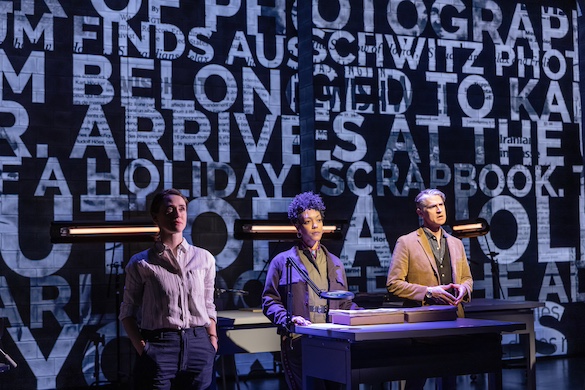‘Here There Are Blueberries,’ Centered on Everyday Nazi Life at Auschwitz, Plumbs the Depths of the Banality of Evil
Writer and director Moisés Kaufman and co-writer Amanda Gronich have directed their attention to some of Adolf Eichmann’s similarly notorious cohorts, as well as men — and women — whose names will be unfamiliar to most.

It has been more than 60 years since Hannah Arendt used the term “banality of evil” to argue that Adolf Eichmann’s monstrous actions could be attributed more to the high-ranking Nazi’s shallowness and thoughtlessness than destructive intentions. The almost supernatural malevolence of Eichmann and his collaborators in the Holocaust, their unique ability to mix barbarism with pristine efficiency, has stumped cynics and idealists alike ever since.
For “Here There Are Blueberries,” conceived and directed by “The Laramie Project” creator, Moisés Kaufman, and recently announced as a finalist for this year’s Pulitzer Prize for drama, Mr. Kaufman and co-writer Amanda Gronich have directed their attention to some of Eichmann’s similarly notorious cohorts, as well as men — and women — whose names will be unfamiliar to most.
Inspired by the discovery in 2007 of a previously unknown collection of photographs documenting life at Auschwitz — not among the prisoners, but among the officials who oversaw their abuse and slaughter — “Blueberries,” through much of its 90-minute duration, sustains the deceptively measured, earnest tone of a museum tour. Several of the characters are in fact employees of the U.S. Holocaust Memorial Museum, who obtained the photo album from a retired American intelligence officer six decades after he first found it, while living in Germany just after the war.
Mr. Kaufman’s docu-dramatic approach relies on images as much as words, with the latter inspired by interviews, transcripts, and other primary sources, though not blindly loyal to them. (A note in the text acknowledges “the customary liberties of the dramatist.”) At the play’s beginning, it is explained how the development of compact, portable cameras did much to encourage “the pursuit of happiness” among Germans in the 1930s, as the country emerged from a depression.

David Bengali’s projection design, which will be key to the production throughout, reveals a series of snapshots that seem sweetly quaint at first, but gradually grow more disturbing. At one point, we see young children waving flags emblazoned with swastikas; the next photo shows a group of grinning young women, their arms stiffly outstretched in what has become history’s most chilling salute.
“The apparent ordinariness of these images does not detract from their political relevance,” our guide — one of eight actors who juggle a variety of roles, often addressing the audience directly — points out. “On the contrary: Asserting ordinariness in the face of the extraordinary is, in itself, an immensely political act.”
We learn that the central photo album had been the property of Karl Höcker, a bank teller who found his true calling as executive assistant to SS Major Richard Baer, who ran Auschwitz as the war was winding down. Through the pictures, we also meet names that would live on in infamy, among them “Angel of Death” Josef Mengele and Rudolf Höss, Auschwitz’s original commandant, whose savagery informed Martin Amis’s novel “The Zone of Interest” and inspired last year’s film adaptation.
Yet the most chilling photos capture the relaxed, often smiling faces of the lower-level officials and workers who executed their orders. They include the “Helferinnen,” as female telegraph operators who managed communication were called; these ladies, we’re informed, “had to be approved as racially pure. Fit to flirt, mate and marry with SS men.” None were sentenced for war crimes, we’re told.
Because much of the play’s focus is on these perpetrators as opposed to victims, audience members are more likely to feel outrage than sadness. Under Mr. Kaufman’s guidance, the actors — among them Elizabeth Stahlmann, who contributes a good chunk of the narration playing Holocaust historian and author Rebecca Erbelding, and the great Kathleen Chalfant, whose roles include survivor and memoirist Judy Cohen — refrain from sensationalism; horrors like these would defy such an approach.
One segment features an interview with Rainer Höss, the Nazi commandant’s grandson, whose controlled bitterness is expertly conveyed by Charlie Thurston. “My family always said to the press: ‘We never saw anything,’” Rainer notes. “They knew exactly what was going on, what happened on the other side of their wall.”
So, of course, did many who were further removed from the atrocities. At a time of burgeoning antisemitism, “Blueberries” delivers, with discretion and grace, a sobering reminder of the terrible things that seemingly ordinary people can be driven to do — or to simply abide.

